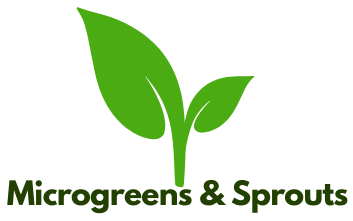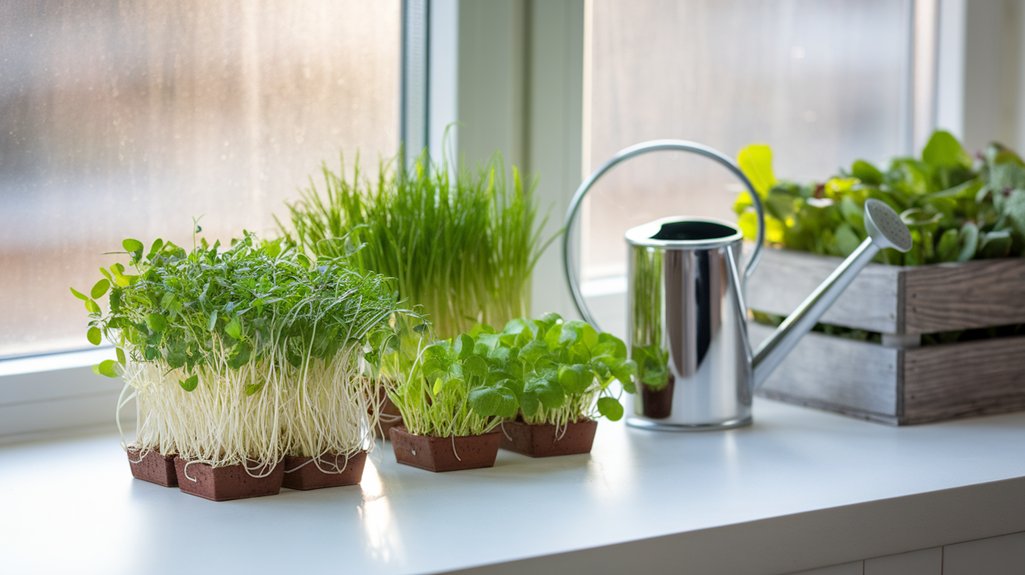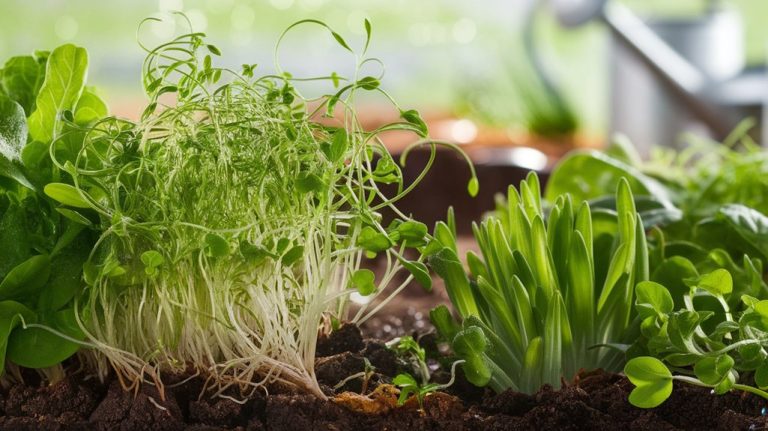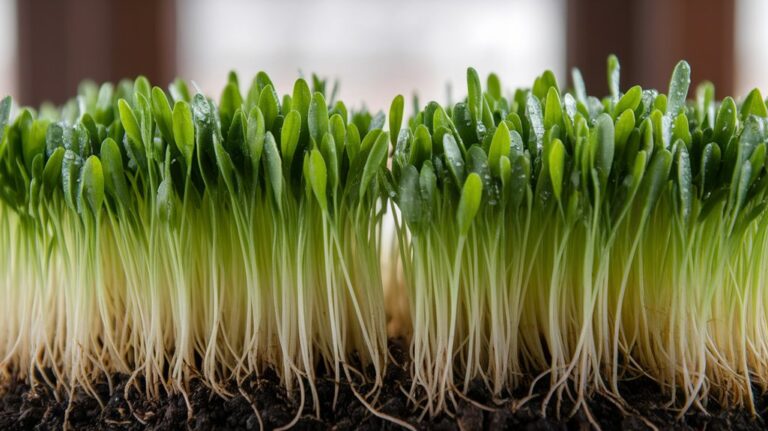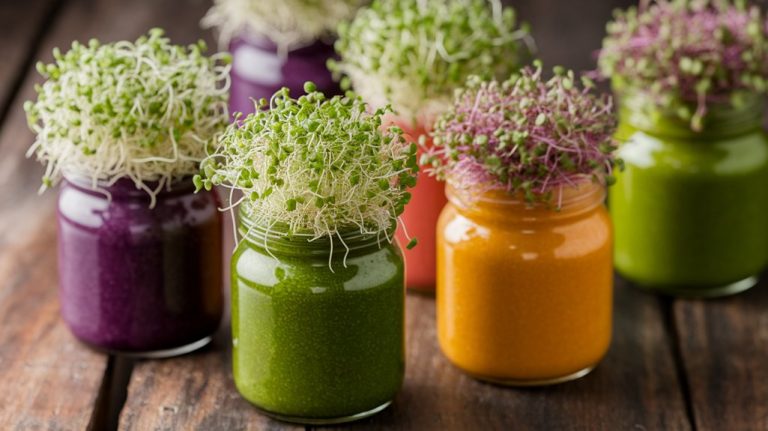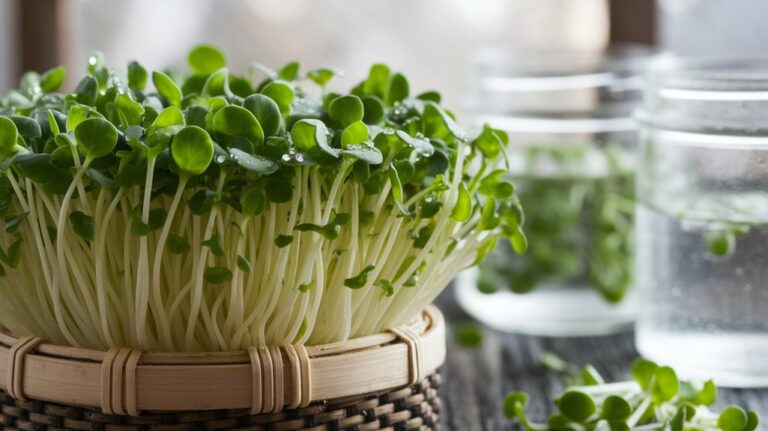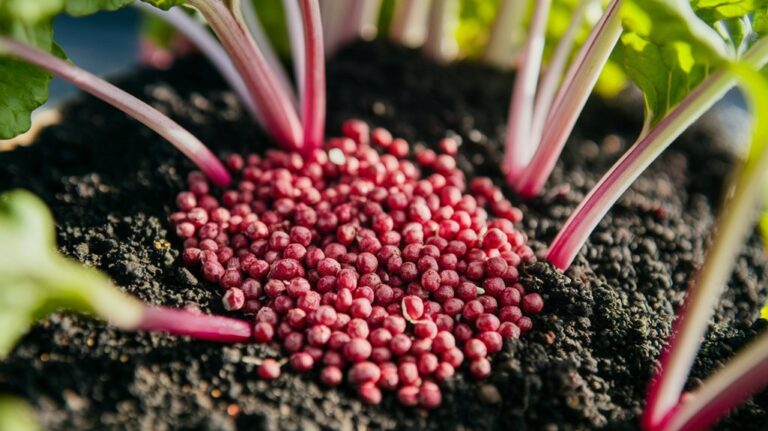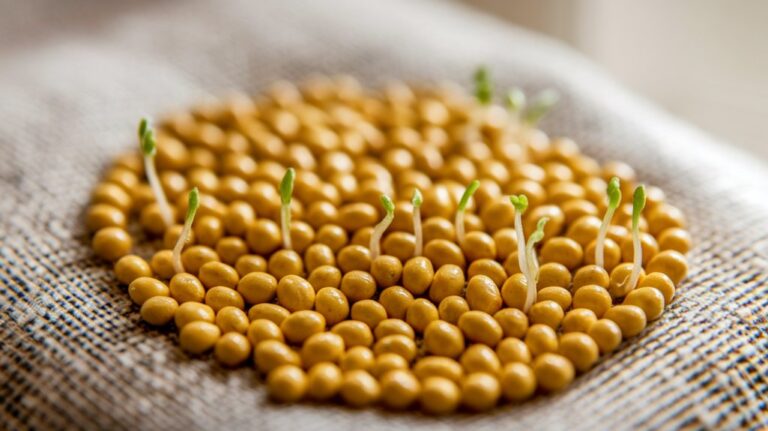Sprout Your Way to Health: Easy Indoor Gardening Hacks
Indoor gardening’s a great way to boost my health and home. I first choose the right plants based on light and space; low-light favorites are snake plants and pothos. Quality pots with drainage holes and nutrient-rich soil are essential tools I can’t overlook. I also monitor light and rotate my plants for even growth. With a bit of care, I enjoy fresh produce and improved air quality. Discover more tips to elevate your indoor garden.
Key Takeaways
- Choose low-maintenance plants like snake plants or pothos for easy care and health benefits in low-light conditions.
- Use quality potting soil and organic nutrients to enhance plant growth and improve air quality indoors.
- Position plants near windows or use grow lights to ensure they receive adequate light for optimal health.
- Regularly monitor soil moisture and adjust watering schedules to prevent over or under-watering, promoting healthy growth.
- Engage in routine plant care, including pruning and pest monitoring, to maintain a thriving indoor garden and reduce stress.
Choosing the Right Indoor Plants for Your Space
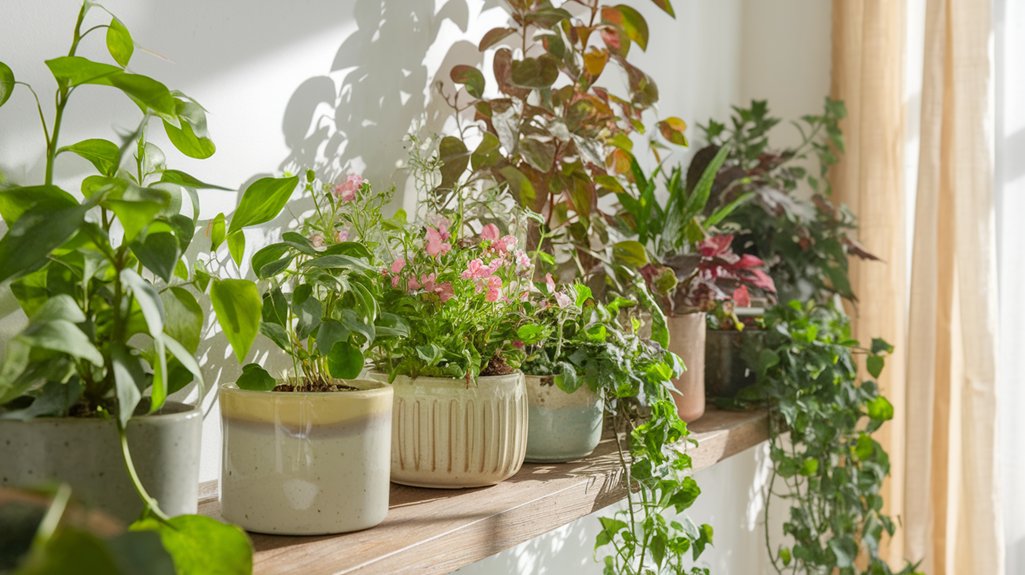
When I first started my indoor gardening journey, I quickly realized that choosing the right plants for my space was crucial.
I looked around my home and considered factors like light, humidity, and temperature. For instance, if your space is low on natural light, I’d recommend opting for hardy plants like snake plants or pothos. They thrive in low-light conditions and require minimal care.
On the other hand, if you have bright, sunny windows, succulents or herbs could flourish beautifully.
Also, think about your lifestyle—if you’re often busy, low-maintenance plants like ZZ plants might be perfect.
Essential Tools for Successful Indoor Gardening
When it comes to indoor gardening, having the right tools can make all the difference.
I’ve found that a few essential supplies and plant care tools not only simplify the process but also enhance my plants’ growth.
Let’s explore the must-haves and accessories that can help you succeed in your indoor gardening journey.
Must-Have Gardening Supplies
If you’re diving into indoor gardening, having the right supplies can make all the difference.
First, invest in quality pots with drainage holes; they’re key for preventing waterlogged roots. I also recommend potting soil specifically designed for indoor plants, as it provides the right nutrients.
A sturdy watering can is essential, too—choose one with a long nozzle for easy access to tight spots.
Don’t forget a good pair of pruning shears; they’ll help maintain your plants’ shape and health.
Lastly, a moisture meter can be a game changer, allowing you to monitor soil moisture levels accurately.
With these must-have supplies, you’ll be well on your way to creating a thriving indoor garden!
Essential Plant Care Tools
While cultivating an indoor garden, having the right plant care tools can truly elevate your gardening experience. I’ve found that a few essential tools not only make my life easier but also help my plants thrive. Check out this handy table to see what you might need:
| Tool | Purpose |
|---|---|
| Watering Can | For accurate watering |
| Pruning Shears | To trim and shape plants |
| Soil Scoop | For easy soil handling |
| Humidity Meter | To monitor moisture levels |
| Plant Labels | For keeping track of species |
Investing in these tools can enhance your gardening routine, making maintenance a breeze and ensuring your indoor oasis flourishes with life!
Indoor Gardening Accessories List
To create a thriving indoor garden, I’ve discovered that the right accessories can make all the difference.
First up, you’ll need quality pots with drainage holes to prevent overwatering. A moisture meter is essential for checking soil hydration accurately.
I also recommend investing in grow lights; they’re perfect for those low-light spots in your home. Don’t forget a good pair of pruning shears for maintaining healthy plants, and a spray bottle for misting those humidity-loving varieties.
A sturdy plant stand can elevate your greens and save space. Lastly, keep a journal to track your plant’s progress and care routine.
With these accessories, you’ll set yourself up for indoor gardening success!
Maximizing Small Spaces With Vertical Gardening
If you’re short on space but still want to create a lush indoor garden, vertical gardening is the way to go.
I’ve found that choosing the right plants and exploring DIY vertical garden ideas can really transform any small area.
Plus, using space-saving shelf solutions makes it easy to maximize every inch of your home!
Ideal Plants for Vertical
Choosing the right plants for vertical gardening can transform even the tiniest spaces into lush green sanctuaries.
I love using herbs like basil, mint, and parsley because they’re compact and can thrive in smaller containers. Succulents are another fantastic option; they require minimal care and come in various shapes and colors, adding visual interest.
If you’re looking for flowering plants, consider trailing varieties like nasturtiums or petunias—they cascade beautifully and attract pollinators. For a vibrant touch, you can’t go wrong with ferns, which thrive in indirect light and add a lovely texture.
Ultimately, choose plants that suit your space, lighting conditions, and personal taste. With the right selections, your vertical garden will flourish!
DIY Vertical Garden Ideas
While I love the idea of transforming my small living space with a vertical garden, the best part is how easy it can be to create one yourself.
Start by choosing a wall or empty corner, then consider using wall-mounted planters or repurposed pallets. You can even hang small pots with macramé for a boho vibe.
For a more structured look, vertical frames or grids work wonders. Just make sure to select plants that thrive in your light conditions, like herbs or trailing vines.
Remember to group your plants by water needs for easier maintenance. With a little creativity and effort, you’ll not only maximize space but also bring life and greenery into your home!
Space-Saving Shelf Solutions
Building on those vertical garden ideas, space-saving shelf solutions can further maximize your small living area while showcasing your green thumb.
I’ve found that utilizing shelves not only elevates your plants but also adds character to your home. Here are some easy ways to create your own indoor garden:
- Use tiered plant stands to create levels, making every plant visible.
- Repurpose old bookshelves to house pots and herbs, giving them a second life.
- Install wall-mounted planters to save floor space while adding a touch of nature.
- Incorporate hanging shelves to bring greenery up high, freeing up surfaces below.
These solutions keep your space organized and foster a lush atmosphere that’ll make anyone feel inspired!
Soil and Nutrients: The Foundation of Healthy Plants
Soil serves as the lifeblood for indoor plants, providing essential nutrients and support for growth.
When I choose soil, I look for a mix that’s designed specifically for indoor gardening. A well-draining potting mix usually contains peat, vermiculite, and perlite, ensuring that my plants get the moisture they need without becoming waterlogged.
I also make sure to enrich the soil with organic nutrients, like compost or worm castings. These additions enhance the soil structure and provide vital minerals.
Regularly testing the pH levels helps me keep my plants happy, too. If it’s too acidic or alkaline, I can adjust it with simple amendments.
With the right soil and nutrients, my indoor garden thrives beautifully!
Tips for Maintaining Optimal Light Conditions
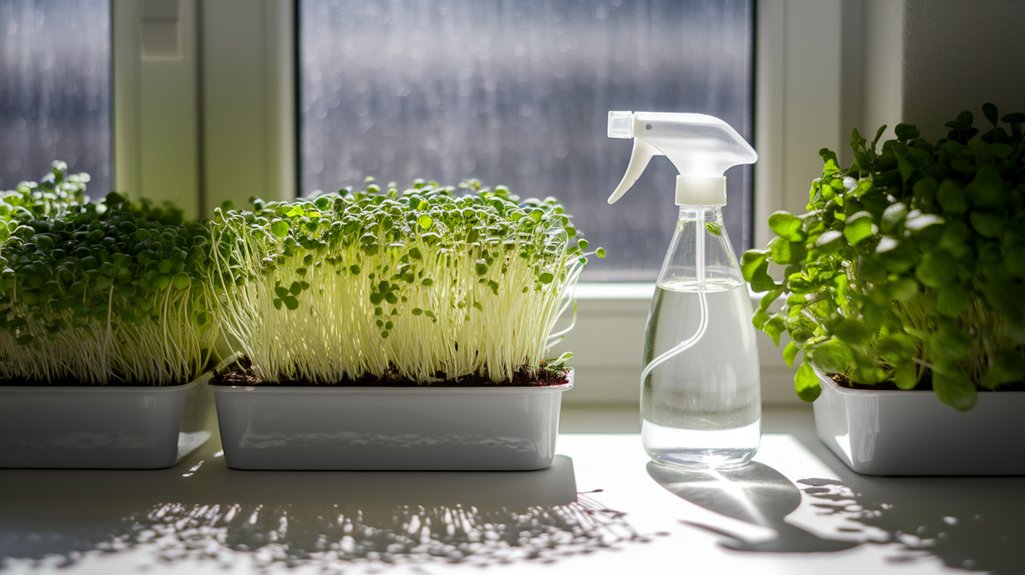
After ensuring that my plants have the right soil and nutrients, I turn my attention to light conditions, which play a significant role in their overall health.
Finding the perfect light can be a game-changer for indoor gardening. Here are some tips I’ve found crucial:
- Position your plants strategically near windows for maximum natural light.
- Rotate your pots regularly to ensure even growth on all sides.
- Use grow lights if natural light is insufficient, especially in winter months.
- Monitor light duration; most plants thrive with 12-16 hours of light daily.
Harvesting and Using Your Homegrown Produce
Harvesting my homegrown produce is one of the most rewarding aspects of indoor gardening. I love the moment when I pluck fresh herbs or vibrant vegetables, knowing I’ve nurtured them from tiny seeds to delicious food.
Timing is crucial; I usually check for ripeness daily. For leafy greens, I simply snip the outer leaves, allowing the center to continue growing. When it comes to herbs, I harvest in the morning for maximum flavor.
After gathering my bounty, I enjoy experimenting in the kitchen. Fresh basil elevates a simple pasta dish, while homegrown tomatoes make the perfect salad.
Using my produce not only enhances meals but also brings a sense of accomplishment. So, get ready to savor the fruits of your labor!
Frequently Asked Questions
How Often Should I Water My Indoor Plants?
When it comes to watering my indoor plants, I’ve learned it’s all about balance. I usually check the soil moisture first—if the top inch feels dry, it’s time to water.
Generally, I water my plants every week, but some might need it more or less often. It’s important to observe each plant’s needs, as factors like light and humidity can affect how quickly the soil dries out.
Consistency is key!
Can I Grow Herbs Indoors Year-Round?
Absolutely, you can grow herbs indoors year-round! I’ve had great success with basil, parsley, and mint right on my kitchen windowsill.
Just make sure they get enough light—using a grow light can really help during the darker months.
I keep the soil moist, but not soggy, and I rotate my pots occasionally for even growth.
It’s so rewarding to have fresh herbs at my fingertips, no matter the season!
What Pests Should I Watch for in Indoor Gardens?
When I garden indoors, I keep an eye out for a few common pests.
Aphids, spider mites, and fungus gnats often invade my plants. I’ve learned that inspecting leaves regularly helps catch them early. If I spot any, I act quickly with neem oil or insecticidal soap.
It’s also crucial to maintain good air circulation and avoid overwatering, as this can attract unwanted critters. Staying proactive really saves my plants!
How Do I Propagate Indoor Plants Easily?
Propagating indoor plants is easier than you might think!
I usually start by taking a healthy cutting and placing it in water or moist soil. For water propagation, I ensure the cut end is submerged but not the leaves. I change the water regularly to keep it fresh.
If I use soil, I keep it lightly moist and cover it with a plastic bag to create humidity. In a few weeks, I see roots forming!
Are There Any Indoor Plants Safe for Pets?
I totally understand the concern about finding pet-safe indoor plants!
Some great options I’ve discovered are spider plants, Boston ferns, and peace lilies. They not only brighten up the space but also keep my furry friends safe.
I love how they’re easy to care for and thrive indoors. Just make sure to double-check each plant, as some varieties can be toxic.
With a bit of research, you can create a pet-friendly green oasis!
Conclusion
Indoor gardening has transformed my space and health, and I’m sure it can do the same for you! By choosing the right plants, utilizing essential tools, and maximizing your area, you can create a thriving green oasis. Don’t forget about soil, light, and regular maintenance—it all contributes to your success. So, grab your gardening gloves and start sprouting your way to health. You’ll love the fresh produce and the joy of nurturing your plants!
